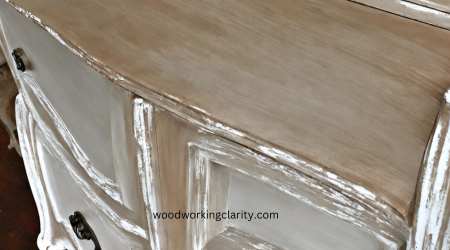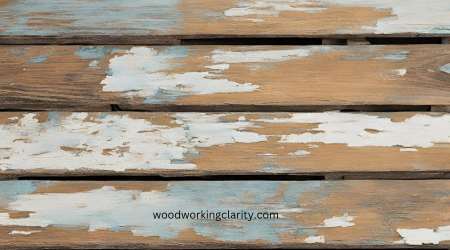Using a paint stripper is one of the easiest methods of removing dry paint from surfaces. So learning how to use Citristrip stripping gel will go a long way in your woodworking projects. It not only saves you the effort but also time since it’s fast-acting.
This guide will take you through the essential tools and materials you will need when stripping paint, citristrip directions, and a few helpful tips to help make this entire process seamless.
So read on and find out the details. It’s pretty straightforward.
What is Citristrip Stripping Gel?
Citristrip stripping gel is a special orange-colored paint and varnish chemical stripper. It’s characterized by a pleasant citrus scent, unlike other paint strippers with harsh fumes.
Citristrip stripper gel can stay active for up to 24 hours and is therefore perfect for removing thick layers of dried latex, oil-based paint, varnish, lacquer, polyurethane, and shellac from wood metal and old houses.
Citristrip Ingredients
The primary ingredient in Citristrip is citrus acid, which acts as an organic solvent and dissolves paint from surfaces like wood, metal, or even painted walls.
This citrus stripper doesn’t contain methylene chloride or NMP; it’s non-caustic and therefore safe for use indoors or outdoors.
How to use Citristrip stripping gel to strip furniture
First, prepare your furniture. Next, apply the first coat of the citrus strip, then spread the second coat of the stripper for thickness. Let the gel work for a while, then scrape off the paint and gel residue. Finally, wash the surface with odorless mineral spirits.
That’s the snippet version. But, there’re several details and steps involved in the stripping process which we’ll discuss.
So, let’s focus on using Citristrip stripping gel to strip wood furniture. Even though the process is almost identical for other surfaces, the variation lies in the tiny details.
Tools and materials
- Citristrip paint and varnish stripping gel
- Saran wrap
- Painter’s plastic or dropcloth
- Paint brush
- Steel wool
- Odorless mineral spirits or paint stripping after wash
- Wire brush
- Clean cloth
- Plastic putty knife or paint scraper
- Metal container
- Chemical resistant gloves
- Mask or respirator
- Chemical splash goggles
How to Strip Furniture with Citristrip (Step by Step)
Step 1: Preparation
Safety preparation is critical for every refinishing project.
As much as Citristrip is a safe stripper, it’s still a chemical stripper that could irritate your skin and eyes in case of contact. That’s why you need to wear chemical-resistant gloves such as nitrile gloves because Citristrip eats up rubber or latex gloves.
Also, wear your safety glasses to protect your eyes if you can’t find chemical splash goggles.
Ensure you follow the general rule of thumb; work in a well-ventilated space. If you can work outside in the open air, the better: If not, it is best to wear a respirator with a filter cartridge.
The next thing you want to do is line a carpenter’s plastic or drop cloth on the floor beneath and around the painted furniture you want to strip to collect the excess stripper from landing on a surface it shouldn’t.
If necessary, tape down the plastic wrap so it doesn’t move around and end up soiling the surface with debris.
If you plan to strip a piece of painted furniture with moving parts such as drawers or hardware, it’s best to separate them beforehand and then strip them separately later on.
Tip
Lightly sand the surface of your furniture before you apply the stripper. This helps the stripper to penetrate the layers of paint quickly. Of course, it’s okay if you skip this part.
Step 2: Apply a thick coat Of Citristrip Gel
We recommend using an old paintbrush or a chip brush you don’t mind disposing of once you’re done stripping.
First, shake the Citristrip bottle, pour the stripping gel into a metal container, then dip a paintbrush in the gel stripper and apply it to the furniture you want to strip.
Alternatively, you can pour the orange stripper on a few places on the surface of the piece of furniture you want to remove paint from stained wood. Then use a paintbrush to spread a liberal coat of the gel stripper to every inch of the old paint on your furniture.
Apply gel stripper super thick to every intricate joint and corner of your furniture. If your furniture has drawers and or hardware, this is the step where you coat them with the citrus stripper as well.
Apply a second coat of the stripper; to be sure you have a thick coat of the stripper for better results when you scrape it off. Be careful not to overbrush the gel; otherwise, you are only going to thin it out.
Step 3: Allow time for the stripper to work
The instructions manual on the Citristrip container and their website indicate that you can leave the stripper on for a minimum of 30 minutes and a maximum of 24 hours, provided the stripper remains wet.
How long does Citristrip take to work? The amount of time you leave the stripper depends on the coats of stripping gel applied and the layers of paint or varnish you hope to strip from your piece of furniture.
You can cover the gel stripper on your piece of furniture with saran wrap. This will ensure the gel stays wet for a longer time than it would if left exposed: therefore better-stripping powers of the Citristrip stripper.
You will know that its stripper has worked its magic enough when you see bubbles formed on the surface. You may also notice the paint looking fluffy and slightly separated from the natural wood.

Step 4: Stripping furniture with Citristrip
Scrape a small area to confirm if the paint or varnish is ready to come off. If the paint easily separates from the wood beneath, proceed: If it doesn’t, then allow it more time.
Begin scraping the loose paint using a plastic putty knife. Push it against the gelled surface to lift the loose gunk.
Ensure you push the putty knife slightly beneath the layers of paint build-up, then glide it through to the other end, all this while going in the direction of the wood grain.
Using plastic tools helps you avoid damaging the wood if you accidentally dig into the wooden surface, unlike using a metal putty knife.
You can drop the debris on the drop cloth lined on the floor or in a separate trash bag. Wipe the edge of the plastic putty knife with a paper towel to remove build-up.
Use a wire brush paint removal method and gel striper from areas hard to reach with a putty knife.
Once you’re done removing paint layers and gel strippers from your furniture, you need to determine whether your project is good enough or needs another coat of the stripper.
Step 5: Clean the surface
You need to clean the stripped furniture using either mineral spirits or paint stripper after washing. This step helps to break and remove wax that was contained in the gel stripper.
Use fine steel wool and odorless mineral spirits and gently scrub the entire surface of the furniture, adding more mineral spirits where needed. Ensure you cover every inch of the wood.
Then soak a clean cloth in mineral spirits and use it to wipe down every lingering paint residue from the surface. Finally, use a white lint-free cloth to be able to tell if there’re any more residues left.
If you have Paint Stripper After Wash at your disposal, use it the same way you would, mineral spirits. You can use this product from the Citristrip or Klean Strip brand.
Once the stripped piece is paint-free, allow it sufficient time to completely dry before you re-stain or refinish your furniture.
This step applies to detached pieces of furniture as well. Again, remember to paint or stain the separate pieces separately and only put them back together once fully dry.
Why Should You Use Citristrip?
Citristrip is the one of the best paint stripper for removing thick layers of old paint from either wood, metal, or masonry surfaces.
Citristrip is found in a home improvement store near you or on Amazon right here. It’s also super easy to use. We covered the steps of using it above; if you are stranded, how to strip paint from wood with citristrip.
This citrus stripper doesn’t have crazy fumes, unlike other chemical strippers. Instead, you get a citrus scent that’s pleasant as long as you’re using it in a well-ventilated area.
Besides, it’s environmentally friendly and doesn’t have either methylene chloride or NMP.
You can use this stripping gel on both a flat surface and a vertical surface. This is possible because of the stripper’s super thick consistency that clings well and won’t run off on vertical surfaces.
Use this stripper if you want to strip multiple layers in one application. This stripper can remain active for up to 24 hours if you manage to keep it wet. And we have seen how to do it above.
If these aren’t reasons enough for you to use Citristrip, I don’t know what are.
Citristrip gel is also much less expensive than chemical stripper because you use so little of it at a time.
If you’re working on floors, here’s how to remove paint from a wooden floor fast and effectively.

Is Citristrip Safe?
Yes, Citristrip is safe for use and will not damage the surface, making this product ideal for paint removal. Citristrip stripping gel is far superior to traditional chemical strippers in a number of ways. It’s safe, non-toxic, and low-odor.
For indoor usage, it is safe (but still keeps the windows open for ventilation). There is no methylene chloride (non-caustic) in this formula.
Tips for Using Citristrip on Wood
- Read all safety information prior to using Citristrip.
- Apply Citristrip to dry surfaces.
- Be patient. Citristrip needs some time to work.
- Ventilate the area prior to application.
- Dispose of Citristrip properly once you’re done stripping paint.
- Keep the area surrounding the workstation secure when working outside. Be careful when applying Citristrip around plants or grass because this could affect them negatively.
How to Apply Citristrip FAQs
How do you clean up Citristrip?
To remove Citristrip residue, dip fine steel wool ( grade #0000) in mineral spirits or Klean Strip’s Paint Stripper After Wash and use it to scrub off the remaining stubborn traces of paint or varnish. Once there’re no more traces of paint on the furniture, you need to wipe the surface with a clean cloth soaked in mineral spirits or After Wash.
Citristrip temperature
Citristrip works best at temperatures between 80 and 100 degrees Fahrenheit. If you are not sure what temperature your chemical works best with, it is always better to err on the side of caution by starting with a lower temperature and working up from there.
Does Citristrip remove wax?
Yes, CitriStrip can remove wax from your surface, but it will take additional time and effort. Citristrip will dissolve the top layer of the wax on wood surfaces, leaving behind only the natural color beneath.
How to neutralize Citristrip
Okay, you’re not attempting to ‘neutralize’ the Citristrip but rather to get rid of it. If you want the best way to remove Citristrip, consider purchasing a Citristrip Wash. But neutralize the wood after using Citristrip, use a buffer with water.
How to dispose of citristrip
Citristrip may not mix well with other chemicals, so do not dump it down your drain or in your yard waste bin. In many areas, you should check for disposal instructions from the city where you live.
In other cases, there may be a take-back program from the manufacturer or you can look for recycling facilities.
If all else fails, your local landfill should accept Citristrip containers as long as they are properly sealed and labeled.
Does citristrip remove stain
Yes, citristrip does remove stains from wood surfaces. Citristrip works on surfaces where you can’t sand, like plastic. If it’s a stain that appears in the wood grain itself, then use a sanding block.
How long to leave Citristrip on?
According to the manufacturer, you can leave Citristrip paint and varnish stripping gel on a surface for a minimum of 30 minutes and a maximum of up to 24 hours. The point is, as long as the stripper remains wet on the surface it is applied to, you can leave it for longer to strip multiple layers of paint or varnish.
Do I have to use mineral spirits after stripping?
You need to use odorless mineral spirits after stripping to help you loosen the residues on the surface of the stripped furniture. You can use an abrasive pad or fine steel wool with a bit of mineral spirits to break down the stubborn bits. Finally, wipe the lingering residues with a clean cloth dampened with mineral spirits.
What is a paint stripper after wash?
Paint Stripper After Wash is a liquid designed to clean and prepare surfaces for refinishing by removing any stripping residue from the wood grain, metal, and masonry surfaces. Its fast-acting formula evaporates pretty quickly and leaves no residue on the stripped surface. It works great for furniture as well as antiques.
Can you leave Citristrip on too long?
According to the Citristrip manufacturer, you can leave Citristrip paint and varnish stripping gel on a surface for up to 24 hours. The condition is, as long as the stripper stays wet on the surface it’s applied to, you can let it sit for long and strip multiple layers of paint or varnish.
Can you use Citristrip stripping gel on metal and masonry surfaces?
Yes. You can use Citristrip all-purpose stripping gel to remove several layers of latex paint, oil-based paint, varnish, lacquer, acrylics, enamel, polyurethane, shellac, and epoxy from metal and masonry surfaces. Apply two layers of a thick coat of the stripping gel on the surface, let it sit for a while, and then remove the loose layers using a wire brush.
How to Use Citrus Paint Remover Summary
This stripping process is the most satisfying for me despite it being messy. I hope you enjoy stripping furniture now because you have learned how to use Citristrip Stripping Gel.
The next time you are faced with a project that requires refinishing and other methods of removing layers of paint is daunting; you won’t be shaken because you can use Citristrip stripping gel with confidence.
Let me know in the comments below if you find this guide helpful. And if you are a seasoned woodworker, we’d love to hear your tips when using Citristrip stripping gel.
For those looking for alternatives, learn how to remove paint from deck without chemicals here.


when i used the citrus stripper on furniture how come the grain of wood is always dark when i used stripper on it.i have agold stain will that cover maghogny look on furniture.